| This article needs additional citations for verification. Please help improve this article by adding citations to reliable sources. Unsourced material may be challenged and removed. Find sources: "Yonghe Temple" – news · newspapers · books · scholar · JSTOR (November 2015) (Learn how and when to remove this message) |
| Yonghe Temple | |
|---|---|
| 雍和宮 | |
 | |
| Religion | |
| Affiliation | Buddhism |
| Sect | Gelug school of Tibetan Buddhism |
| Location | |
| Location | Dongcheng District, Beijing, China |
 | |
| Geographic coordinates | 39°56′49″N 116°24′40″E / 39.94694°N 116.41111°E / 39.94694; 116.41111 |
| Architecture | |
| Style | Chinese architecture |
| Founder | Yongzheng Emperor |
| Date established | 1694 |
| Yonghe Temple | |||||||||||
|---|---|---|---|---|---|---|---|---|---|---|---|
 | |||||||||||
| Chinese name | |||||||||||
| Traditional Chinese | 雍和宮 | ||||||||||
| Simplified Chinese | 雍和宫 | ||||||||||
| |||||||||||
| Tibetan name | |||||||||||
| Tibetan | དགའ་ལྡན་བྱིན་ཆགས་གླིང་ | ||||||||||
| |||||||||||
| Mongolian name | |||||||||||
| Mongolian Cyrillic | Найралт Найрамдyy Сүм | ||||||||||
| |||||||||||
| Manchu name | |||||||||||
| Manchu script | ᡥᡡᠸᠠᠯᡳᠶᠠᠰᡠᠨ ᡥᡡᠸᠠᠯᡳᠶᠠᡴᠠ ᡤᡠᠩ | ||||||||||
| Romanization | hūwaliyasun hūwaliyaka gung | ||||||||||

The Yonghe Temple (Chinese: 雍和宮, "Palace of Peace and Harmony"), also known as the Yonghe Lamasery, or popularly as the Lama Temple, is a temple and monastery of the Gelug school of Tibetan Buddhism located on 12 Yonghegong Street, Dongcheng District, Beijing, China. The building and artwork of the temple is a combination of Han Chinese and Tibetan styles. This building is one of the largest Tibetan Buddhist monasteries in China proper. The current abbot is Lama Hu Xuefeng. Yonghe Temple was the highest Buddhist temple in the country during the middle and late Qing dynasty.
History
Building work on the Yonghe Temple started in 1694 during the Qing dynasty on the site where originally stood an official residence for court eunuchs of the Ming dynasty. It was then converted into the residence of Yinzhen (Prince Yong), the fourth son of the Kangxi Emperor. The Kangxi Emperor awarded this building to Yinzhen in 1702, who was at the time a junwang (second-rank prince). Yinzhen moved into this building in May 1703. The Kangxi Emperor promoted Yinzhen from junwang to qinwang (first-rank prince) under the title "Prince Yong of the First Rank" (和碩雍親王; Héshuò Yōng Qīnwáng; Manchu: hošoi hūwaliyasun cin wang) in 1709. The name of this building was thus changed into 'the Residence of Prince Yong of the First Rank' (雍親王府) in the same year. In 1711, Hongli, the fourth son of Yongzheng, the future Qianlong Emperor, was born in the East Academy (东书院) in this building.
Prince Yong ascended the throne as the Yongzheng Emperor in 1722, and the Residence of Prince Yong of the First Rank was later promoted into the 'Palace of Peace and Harmony' (雍和宫). After the Yongzheng Emperor's death in 1735, his coffin was placed in the temple from 1735 to 1737. Before the Yonghe Temple was converted into a monastery, the Grand Secretariat Ortai had once proposed that Hongzhou (Prince He) should take the Yonghe Palace as his private residence, but this suggestion was denied by the Qianlong Emperor. The Qianlong Emperor, who succeeded the Yongzheng Emperor, gave the temple imperial status signified by having its turquoise tiles replaced with yellow tiles which were reserved for the emperor. In 1744, the Qianlong Emperor issued an edict of converting the Palace of Peace and Harmony into a lamasery, and the following Buddhābhiṣeka (开光 Kaiguang) of the Buddhist figure was executed in 1745.
Subsequently, the monastery became a residence for large numbers of Tibetan Buddhist monks from Mongolia and Tibet, and so the Yonghe Lamasery became the national centre of Lama administration. Since 1792, with the foundation of the Golden Urn, the Yonghe Temple also became a place for the Qing dynasty to exert control over the Tibetan and Mongolian lama reincarnations.
The temple was the site of an armed revolt against the Chinese Nationalist government in 1929.
After the Chinese Civil War ended in 1949, the temple was declared a national monument and closed for the following 32 years. It is said to have survived the Cultural Revolution due to the intervention of Premier Zhou Enlai. Reopened to the public in 1981, it is today both a functioning temple and highly popular tourist attraction in the city.
Administration
After the Yonghegong Temple was converted into a monastery, its management can be divided into two parts: administrative affairs management and religious affairs management. In terms of administration, the Yonghe Temple is treated as an imperial Tibetan Buddhist temple directly under the jurisdiction of the Qing dynasty. The emperor would appoint a prince or a junwang (second-rank prince) as the responsible of the temple's secular business, and delegate the actual management affairs to the Imperial Household Department and the Ministry of Foreign Affairs. The religious affair of the Yonghe Temple is handled by a Khenpo lama (管理雍和宮總堪布喇嘛) as the head of the monastery. This position is usually held by lamas from Tibet, and is higher in status than the usual Zhasake (Manchu: jasak i da lama) lamas. It is worth noting that since 1936, the term used to address the religious head of the Yonghe Temple has changed from khenpo to abbot (CN: 住持)
Layout
(See the map attached)
- Memorial Archway
- Imperial Carriage Pathway
- Toilet
- Zhaotai Gate
- Drum tower
- Bell tower
- West Stele Pavilion
- East Stele Pavilion
- West Ase Gate
- East Ase Gate
- Yonghe Gate Hall
- Four-Language Stele Pavilion
- Exoteric Hall
- Esoteric Hall
- Shilun Hall
- Medicine Hall
- Yonghegong Hal
- Yongyou Hall
- West Side Hall
- Eate Side Hall
- Falun Hall
- Jietai Building
- Panchen Building
- Wanfuge Pavilion
- Yansui Pavilion
- Yongkang Pavilion
- Yamudaga Building
- Zhaofo Building
- Suicheng Hall
- West Shunshan Building
- East Shunshan Building
- The Residence of A Jia Rinpoche
- Souvenir store
- Ticket Center
- Reception
- Tourist Center
- Buddhābhiṣeka Center
Architecture and artworks
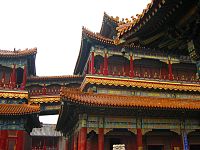

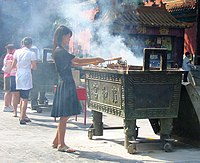
The Yonghe Temple is arranged along a north–south central axis, which has a length of 480 metres (1,570 ft), and covers an area of 66,400 square kilometres (25,600 sq mi). The main gate, the Gate of Clarity and Prosperity (Zhaotaimen) is at the southern end of this axis, along with three memorial archways in the front. And a path built for imperial carriages (Niandao) is situated between the front memorial archway and the Gate of Clarity and Prosperity. Along the axis, there are five main halls which are separated by courtyards: the Gate Hall of Harmony and Peace (Yonghemendian), the Hall of Harmony and Peace (Yonghegong), the Hall of Everlasting Protection (Yongyoudian), the Hall of the Wheel of the Law (Falundian), and the Pavilion of Ten Thousand Happinesses (Wanfuge).
The Gate Hall of Harmony and Peace is the southernmost of the main halls, it served originally as the main entrance of the palace, but was later changed into the Hall of Heavenly Kings (Tianwangdian). In the center of the hall stands a statue of the Maitreya Buddha, along the walls statues of the four Heavenly Kings are arranged. There sit two stele pavilions in front of the Gate Hall of Harmony and Peace, which contain the stele of the Yonghe Temple and the stele of the Discourse of Lamas.
The Hall of Harmony and Peace is the main building of the temple. It houses three bronze statues of the Buddhas of the Three Ages, the statue of the Gautama Buddha (Buddha of the Present) is in the center, it is flanked by the statue of Dīpankara Buddha (Buddha of the Past, right) and the Maitreya Buddha (Buddha of the Future, left). Along the sides of the hall, the statues of the 18 Arhats are placed. A mural in the hall shows the bodhisattva Avalokitesvara.
The Hall of Everlasting Protection was Emperor Yongzheng's living quarters as a prince and the place where his coffin was placed after his death. Today, a statue of the Bhaisajya-guru (healing Buddha) stands in this hall.
The Hall of the Wheel of the Law functions as a place for reading scriptures and conducting religious ceremonies. It contains a large statue of Je Tsongkhapa, founder of the Geluk School. The hall also contains the Five-Hundred-Arhat-Hill, a carving made of red sandalwood with statues of the arhats made from five different metals (gold, silver, copper, iron, and tin).
The Pavilion of Ten Thousand Happinesses (sometimes referred to as "The Hall of Boundless Happiness") contains an 18 metres (59 ft) tall (with an additional 8 metres (26 ft) underground, making it 26 metres (85 ft) in total) statue of the Maitreya Buddha carved from a single piece of White Sandalwood. This was a gift from the seventh Dalai Lama to the Qianlong Emperor and took three years to transport from Tibet to Beijing. The statue is one of three artworks in the Temple which were included in the Guinness Book of Records in 1993.
Three fabulous artworks
- three bronze statues of the Buddhas of the Three Ages
- Five-Hundred-Arhat-Hill
- 18m tall White Sandalwood statue of the Maitreya Buddha
Two steles
The Yonghe Temple contains two steles built during the reign of the Qianlong Emperor. Both of them are written in Chinese, Manchu, Tibetan, and Mongolian. The first one is the Yonghegong Stele, erected in 1744, signaling the palace's conversion into a lama monastery. The second one is The Discourse of Lama, a stele erected in 1792, which is written by the Qianlong Emperor to target the wrongdoing of the Tibetan lamas in handling the reincarnation issues. Both steles are well-preserved in the two pavilions in front of the Yonghe Gate.
Cham Dance
Being a Tibetan Buddhist temple, the Yonghe temple also inherits rituals and dances from Tibet. The temple has adopted the tradition of the Cham dance, or bujak in Manchu, shortly after its conversion into a lama monastery. The first record of the practice of cham dance in Yonghe Temple was first found in 1746, at a banquet hosted by the Qianlong emperor in hosting a Dzungar envoy. This ritual is hosted on every 28th day of the 12th lunar month and the fourth day of the first lunar month in the period after its foundation. During the reign of the Guangxu Emperor, the tradition was rescheduled as an eight-day performance starts from the 23rd of the first lunar year to the 1st of the second lunar year. Due to the closure of the Yonghe Temple in the Cultural Revolution period, the cham dance was also suspended. It was not revived until 1987.
Location
The Yonghe Temple is located in Beijing's Dongcheng District, near the northeastern corner of the Second Ring Road. The postal address is: 12 Yonghegong Dajie, Beixinqiao, Dongcheng District, Beijing. The Yonghe Temple and the Forbidden City are about five kilometers apart, about an hour's walk away.
Transport
Lines 2 and 5 of the Beijing Subway both stop at Yonghegong Lama Temple station, as do a number of city buses.
Gallery
-
 A Chinese guardian lion outside the temple
A Chinese guardian lion outside the temple
-
 A pailou with 群生仁壽 inscribed on it, at the entrance to the temple
A pailou with 群生仁壽 inscribed on it, at the entrance to the temple
-
 A giant ancient bell
A giant ancient bell
-
 The Hall of Harmony and Peace (雍和宮)
The Hall of Harmony and Peace (雍和宮)
-
 The Hall of Everlasting Protection (永佑殿)
The Hall of Everlasting Protection (永佑殿)
-
 The Pavilion of Ten Thousand Happinesses (萬福閣)
The Pavilion of Ten Thousand Happinesses (萬福閣)
-
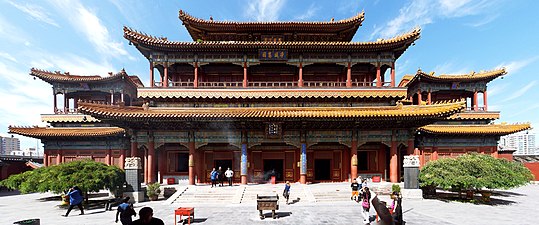 The Pavilion of Ten Thousand Happinesses
The Pavilion of Ten Thousand Happinesses
-
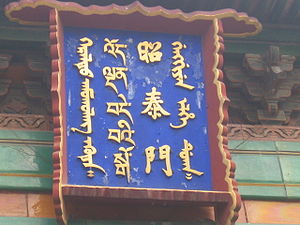 A sign of Symbol Thriving Gate (昭泰門)
A sign of Symbol Thriving Gate (昭泰門)
-
Statue of Tsongkhapa
-
 Statue of Wei Tuo
Statue of Wei Tuo
-
 Statue of the Maitreya Buddha
Statue of the Maitreya Buddha
-
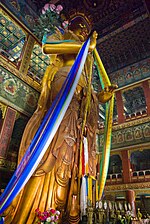 Statue of the Maitreya Buddha
Statue of the Maitreya Buddha
-
 A prayer wheel
A prayer wheel
-
 A wall decoration
A wall decoration
-
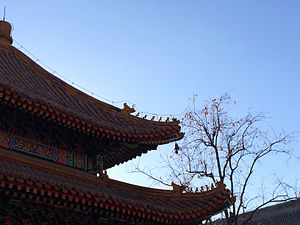 Roof at Yonghe Temple
Roof at Yonghe Temple
-
 Monks in the Yonghe Temple
Monks in the Yonghe Temple
Further reading
- Lessing, Ferdinand, and Gösta Montell. Yung-Ho-Kung, an Iconography of the Lamaist Cathedral in Peking: With Notes on Lamaist Mythology and Cult. Stockholm: 1942.
References
- "两会连线:雍和宫住持胡雪峰称藏传佛教要坚持中国化方向_宗教_中国西藏网". www.tibet.cn. Retrieved 21 February 2021.
- "Lama Temple (Yonghe Temple) Facts, Maps, Buddha, Transportation". www.chinadiscovery.com. Retrieved 5 December 2021.
- Co-edited by Zhong Guo Di Yi Li Shi Dang An Guan and Yong He Gong Guan Li Chu, Qing Dai Yong He Gong Dang An Shi Liao (24 vol), Publish: Zhong Guo Min Zu She Ying Yi Shu Chu Ban She, Beijing, 2004
- ^ Zhao LZ & Guo ML, Yong He Gong Man Wen Dang An Bian Yi, Vol 1, p.1 Beijing, 2016
- ^ Hu, Xue Feng (11 February 2021). "Beijing Yonghegong Yu Menggu Di Qu Fo Jiao Gao Seng De Guan Xi".
- "Peking Revolt. Regiment of Troops Mutiny". The Singapore Free Press and Mercantile Advertiser. Reuters. 4 March 1929. Retrieved 26 October 2018.
- Zatko, M. (2014). The Rough Guide To Beijing. (fifth edition). Rough Guides. London, UK
- "雍和宫主要堪布、住持简介_中国网". www.china.com.cn. Retrieved 21 February 2021.
- ^ Zatko, M. (2014). The Rough Guide To Beijing. (fifth edition). Rough Guides Ltd. London, UK
- Zhao, Ling Zhi; et al. (2016). YONGHE GONG MANWEN DANG AN YIBIAN. Beijing: Beijing Publisher. p. 5. ISBN 978-7-200-11967-1.
- ^ Bao, Hongfei (2013). Yonghegong Jingang Qumo Shenwu. Beijing: Zhongguo Minzu Sheying Yishu Chubanshe. p. 6. ISBN 978-7-5122-0415-7.
- Lonely Planet Beijing 10th Edition (Oakland, CA: Lonely Planet Publications, 2007), 134.
External links
- Official Yonghe Temple website—(in Chinese)
- Beijingtrip.com: Yonghe Lama Temple
- GoogleMaps: Satellite photo of the Yonghe Temple — centered on the Hall of Everlasting Protection.
- Tibet.cn: "Beijing Lama Temple donates Buddha statue to Mongolia" —(in English)
| Notable Buddhist temples in Beijing | |
|---|---|
|
| Old city of Beijing | |
|---|---|
| Subdivisions | |
| Fortifications and towers | |
| Forbidden City |
|
| Imperial gardens, temples and offices |
|
| Temples and gardens |
|
| Mosques and churches | |
| Foundations | |
|---|---|
| The Buddha | |
| Bodhisattvas | |
| Disciples | |
| Key concepts |
|
| Cosmology | |
| Branches | |
| Practices | |
| Nirvana | |
| Monasticism | |
| Major figures |
|
| Texts | |
| Countries | |
| History |
|
| Philosophy | |
| Culture | |
| Miscellaneous | |
| Comparison | |
| Lists | |
- National Key Buddhist Temples in Han Chinese Area
- Tibetan Buddhist temples in Beijing
- Gelug monasteries and temples
- Tibetan Buddhist temples
- Dongcheng District, Beijing
- Qing dynasty architecture
- Major National Historical and Cultural Sites in Beijing
- Houses completed in 1694
- 1694 establishments in China
- Religious organizations established in 1722
- 18th-century Buddhist temples
- 1720s establishments in China
- Tibetan Buddhism in Asia
- Maitreya